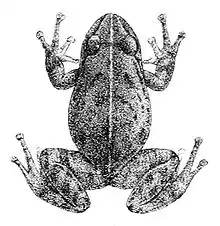Pristimantis unistrigatus
Pristimantis unistrigatus, common name: striped robber frog, is a species of frog in the family Strabomantidae. It is found in the Andean valleys from southern Colombia to central Ecuador.[1][2][3][4]
| Pristimantis unistrigatus | |
|---|---|
 | |
| Scientific classification | |
| Domain: | Eukaryota |
| Kingdom: | Animalia |
| Phylum: | Chordata |
| Class: | Amphibia |
| Order: | Anura |
| Family: | Strabomantidae |
| Genus: | Pristimantis |
| Species: | P. unistrigatus |
| Binomial name | |
| Pristimantis unistrigatus (Günther, 1859) | |
| Synonyms[2] | |
Description
Adult males measure 15–29 mm (0.6–1.1 in) and adult females 23–39 mm (0.9–1.5 in) in snout–vent length. The head is wider than the body in females but equal or narrower in males. The snout is rounded in lateral view and subacuminate to subovoid in dorsal view. The tympanum is visible but not distinct and partly obscured by the supratympanic fold. The finger and toe tips bear discs. Coloration is variable. The most common morph is pale brown above with an indefinite darker interorbital triangle and a series of brown spots forming dorsal chevrons. Another morph is similar to the first one but has a narrow, cream vertebral stripe running through the body. The third form is striped with several tan, medium-brown, and dark brown stripes on the back. Males have an external subgular vocal sac.[5]
The male advertisement call is a hollow click.[5]
Distribution
Pristimantis unistrigatus is found in the Colombian Massif in southern Colombia (Putumayo and Nariño Departments),[4] and in the inter-Andean valleys of Ecuador all way south to the Chimborazo Province.[3]
Habitat and conservation
Pristimantis unistrigatus is a common species found in various open habitats (grasslands and cultivated areas including pastures, ditches, shrubs, croplands) as well as forest edges and even urban areas at elevations of 2,200–3,400 m (7,200–11,200 ft) above sea level.[1] During the day these frogs hide under objects on the ground, occasionally also in arboreal bromeliads. At night they are active on vegetation and on the ground.[5]
The only threat to this species is heavy agrochemical pollution. Its range overlaps with several protected areas.[1]
References
- Luis A. Coloma, Santiago Ron, Lily Rodríguez, Jorge Luis Martinez, Mario Yánez-Muñoz, Ana Almendáriz (2010). "Pristimantis unistrigatus". IUCN Red List of Threatened Species. 2010: e.T57024A11569748. doi:10.2305/IUCN.UK.2010-2.RLTS.T57024A11569748.en. Retrieved 17 November 2021.
{{cite journal}}: CS1 maint: multiple names: authors list (link) - Frost, Darrel R. (2022). "Pristimantis unistrigatus (Günther, 1859)". Amphibian Species of the World: An Online Reference. Version 6.1. American Museum of Natural History. doi:10.5531/db.vz.0001. Retrieved 4 November 2022.
- Ron, S. R.; et al. (2019). Ron, S. R.; Merino-Viteri, A. & Ortiz, D. A. (eds.). "Pristimantis unistrigatus". Anfibios del Ecuador. Version 2019.0. Museo de Zoología, Pontificia Universidad Católica del Ecuador (QCAZ). Retrieved 8 May 2021.
- Acosta Galvis, A. R. (2021). "Pristimantis unistrigatus (Günther, 1859)". Lista de los Anfibios de Colombia: Referencia en linea V.11.2021. Retrieved 8 May 2021.
- Lynch, J. D. (1981). "Leptodactylid frogs of the genus Eleutherodactylus in the Andes of northern Ecuador and adjacent Colombia". Miscellaneous Publication, Museum of Natural History, University of Kansas. 72: 1–46.
